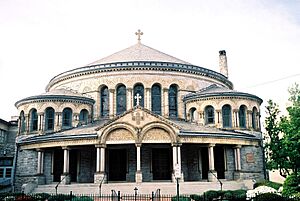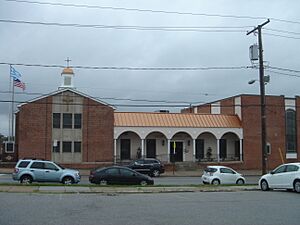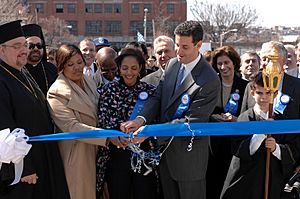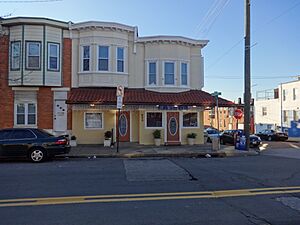History of Greeks in Baltimore facts for kids
The history of Greeks in Baltimore tells the story of how Greek people came to live in Baltimore, Maryland. This started in the late 1800s and early 1900s. Baltimore is now home to one of the biggest Greek American communities in the United States. This community is mainly found in the Greektown and Highlandtown areas of East Baltimore.
Contents
Greek People in Baltimore
In 1920, about 700 people in Baltimore who were born outside the U.S. spoke the Greek language.
By 1940, around 1,200 Greek Americans lived in Baltimore. At that time, about 1,193 immigrants from Greece also lived there. They made up 2% of all white people born in other countries living in the city.
In 2000, the Greek community in the wider Baltimore metropolitan area had about 16,764 people. This was 0.7% of everyone living in that area. In Baltimore city itself, there were 2,693 Greek people, which was 0.4% of the city's population.
By 2013, about 2,611 Greek Americans lived in Baltimore city. This was still 0.4% of the population.
As of 2014, people from Greece were the twenty-fourth largest group of foreign-born people in Baltimore. The Greek language was also the ninth most common language spoken, besides English.
A Look at Greek History in Baltimore
First Greeks Arrive (1800s)
The very first Greeks in Baltimore were nine young boys. They came as refugees after a terrible event called the Chios Massacre. This was when many thousands of Greeks on the island of Chios were killed by the Ottomans during the Greek War of Independence.
More Greek immigrants started to settle in Baltimore in larger numbers during the 1890s.
Growing Community (1900s)
Early Greek settlers built their first churches. The Greek Orthodox Church “Evangelismos” was built in 1906. The Greek Orthodox Cathedral of the Annunciation followed in 1909.
By the 1920s, a lively Greek community was well-established. The St. Nicholas Greek Orthodox Church was built to serve this growing group. Many Greek immigrants came to Baltimore by train from New York City. This was because there was no direct ship service from the Mediterranean Sea to Baltimore's port.
The most Greeks came to Baltimore between the 1930s and the 1950s. The Greek community gained its first voice in local government in 1959. That's when Peter Angelos became the first Greek American elected to the Baltimore City Council.
The Greek population grew again after a new law was passed in 1965. This law allowed thousands more Greeks to immigrate. This wave of Greek immigrants to Baltimore ended by the early 1980s. During the 1980s, Greek residents successfully asked the city to rename their neighborhood. It was then known simply as "the Hill," but it became Greektown. By that time, the Greek community was about 25,000 people strong.
Changes in the 2000s
Today, there is still a strong Greek-American presence in Greektown and Highlandtown. However, the number of Greek people in the community has been going down. The population is getting older, and many have moved out of the original Greek neighborhoods. At the same time, the Latino population is growing quickly in these areas. Most new people moving into the neighborhood are now Latino.
Greek Culture in Baltimore
Baltimore has many Greek-American restaurants. Some popular ones include Ikaros, The Acropolis, The Black Olive, Samos, and Zorba's. There is also a fun annual Greek Folk Festival. It is held at Saint Nicholas Greek Orthodox Church.
Religion
Most Greek Americans in Baltimore belong to the Greek Orthodox Church. However, a small number of them are Greek Jews. Most Greek Jews came to the city in the early 1950s. They mostly came from Thessaloniki, with others from Athens and Patras.
The Greek Jews of Baltimore are mainly Sephardi. There are not many Sephardi Jews in Baltimore. Because there is no special Greek synagogue or group, Sephardi Greek Jews have mostly joined the Ashkenazi Jewish community. They have also adopted many Ashkenazi customs.
However, Greek Jews in Baltimore have tried to keep their Greek Sephardi Orthodox naming customs. They also keep their Greek Sephardi food traditions. For example, during the Passover seder meal, Baltimore's Greek Jews traditionally serve hard-boiled eggs, avgolemono (a lemon-egg sauce) with lamb and matzah balls, latkes (potato pancakes), and almond paste.
Famous Greek Americans from Baltimore
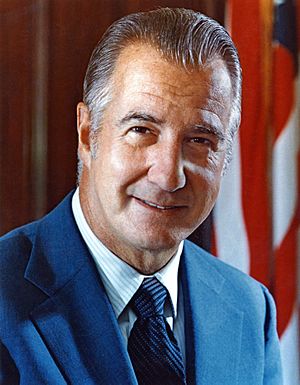
- Spiro Agnew: A politician who served as the 39th Vice President of the United States from 1969 to 1973. He also served as the Governor of Maryland before that.
- Peter Angelos: A lawyer and the main owner of the Baltimore Orioles baseball team.
- Sam Boulmetis, Sr.: A retired horse racing jockey. He was added to the National Museum of Racing and Hall of Fame in 1973.
- Gregg Karukas: A Grammy-winning smooth jazz keyboard player, producer, composer, and pianist.
- Peter Moskos: A former Baltimore Police Department officer. He is now a professor at John Jay College of Criminal Justice.
- John Sarbanes: The U.S. representative for Maryland's 3rd congressional district since 2007.
- Paul Sarbanes: A Democratic politician. He served in the United States House of Representatives from 1971 to 1977. He was also a United States Senator from 1977 to 2007.
- Ioanna Sfekas-Karvelas: A dramatic soprano singer who has performed leading roles in the United States and Europe.
- Stavros Halkias: A comedian and podcast host.
See also


